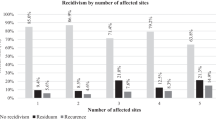Abstract
This study examined the differences between congenital cholesteatoma (CC) and acquired cholesteatomas (AC) in children by comparing clinical features and treatment courses. This was a retrospective study which retrospectively evaluated 127 children with middle ear cholesteatomas using medical records from January 1999 to December 2012 in the Department of Otolaryngology, Niigata University Hospital. The study comprised 69 and 58 cases of CC and AC, respectively. The main outcome measures include patient backgrounds, the opportunities for consultations, mastoid cell development, intraoperative finding of stapes, surgical procedure and number of surgeries. The average age at operation was 6.4 and 9.8 years in CC and AC, respectively. AC was more prevalent in boys. Mastoid development was better in CC than in AC. We adopted a two-stage operation in 17 cases (25 %) of CC and in 22 cases (38 %) of AC. The repeat surgery rate was 11.6 % in CC and 27.6 % in AC. Three times as many operations were required for three cases (4.3 %) of CC and 10 cases (17.2 %) of AC. The lesions in AC were more difficult to control. In the treatment of pediatric middle ear cholesteatoma, we had to keep the outcome in mind.





Similar content being viewed by others
References
Morita Y, Yamamoto Y, Oshima S et al (2014) Acquired cholesteatoma in children: clinical features and surgical outcome. Auris Nasus Larynx 41(5):417–421
De Corso E, Marchese MR, Scarano E et al (2006) Aural acquired cholesteatoma in children: surgical findings, recurrence and functional results. Int J Pediatr Otorhinolaryngol 70(7):1269–1273
Levine JL, Wright CG, Pawlowski KD et al (1998) Postnatal persistence of epidermoid rests in the human middle ear. Laryngoscope 108(1):70–73
Tono T, Aoyagi M, Ito T et al (2010) Staging of middle ear Cholesteatoma 2010. Otol Jpn 20(5):743–745
Tono T (2012) Staging of middle ear cholesteatoma proposed by Japan Otological Society. The 9th international conference on cholesteatoma and ear surgery. Nagasaki, Japan
Potsic WP, Korman SB, Samadi DS et al (2002) Congenital cholesteatoma: 20 years’ experience at The Children’s Hospital of Philadelphia. Otolasyngol Head Neck Surg 126(4):409–414
Nelson M, Roger G, Koltai PJ et al (2002) Congenital cholesteatoma:classification, management, and outcome. Arch Otolaryngol Head Neck Surg 128(7):810–814
Benhammou A, Nguyen DQ, El Makahloufi K et al (2005) Long term results of congenital middle ear cholesteatoma in children. Ann Otlaryngol Chir Cervicofac 122(3):113–119
Lazarrd DS, Roger G, Denoyelle F et al (2007) Congenital cholesteatoma: risk factors for residual disease and retraction pockets—a report on 117 cases. Laryngoscope 117(4):634–637
Matsuoka A (1994) Inflammatory middle ear diseases in children-sex differences. Nippon Jibiinkoka Gakkai Kaiho 97(3):436–449
Kojima H, Tanaka Y, Shiwa M et al (2006) Congenital cholesteatoma clinical features and surgical results. Am J Otolaryngol 27(5):229–305
Iino Y, Imamura Y, Hiraishi M et al (1998) Mastoid pneumatization in children with congenital cholesteatoma: an aspect of the formation of open-type and closed-type cholesteatoma. Laryngoscope 108(7):1071–1076
Nakano Y, Sato Y (1990) Prognosis of otitis media with effusion in children, and size of the mastoid air cell system. Acta Otolaryngol Suppl 471:56–61
McRackan TR, Abdellatif WM, Wanna GB et al (2011) Evaluation of second look procedures for pediatric cholesteatomas. Otolaryngol Head Neck Surg 145(1):154–160
Nevoux J, Lenoir M, Roger G et al (2010) Childhood cholesteatoma. Eur Ann Otorhinolaryngol Head Neck Dis 127(4):143–150
Vercruysse JP, De Foer B, Somers T et al (2008) Mastoid and epitympanic bony obliteration in pediatric cholesteatoma. Otol Neurotol 29(7):953–960
Trinidade A, Skingsley A, Yung MW (2015) Pediatric cholesteatoma surgery using single-staged canal wall down approach: results of a 5-year longitudinal study. Otol Neurotol 36(1):82–85
Drahy A, Barros AD, Lerosey Y et al (2012) Acquired cholesteatoma in children: strategies and medium-term result. Eur Ann Otolaryngol Head Neck Surg 129(5):225–229
Conflict of interest
No conflict of interest.
Author information
Authors and Affiliations
Corresponding author
Rights and permissions
About this article
Cite this article
Morita, Y., Yamamoto, Y., Oshima, S. et al. Pediatric middle ear cholesteatoma: the comparative study of congenital cholesteatoma and acquired cholesteatoma. Eur Arch Otorhinolaryngol 273, 1155–1160 (2016). https://doi.org/10.1007/s00405-015-3679-5
Received:
Accepted:
Published:
Issue Date:
DOI: https://doi.org/10.1007/s00405-015-3679-5




